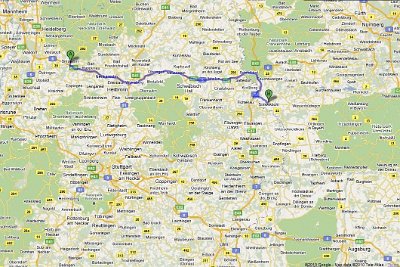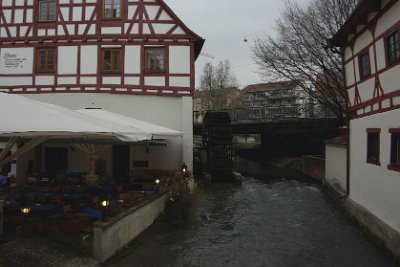 1 Wednesday 14 July, 2010 After our visit to the Sinsheim Museum, we drove 133 kms eastwards to another historical town called Dinkelsbühl. Nürnberg is to the NE and Augsburg is to the SE and Ulm is directly below us. |
 2 Wednesday 14 July, 2010 Dinkelsbühl is surrounded by old medieval walls and towers and is typical of a German town in the 15th to early 17th century. |
 3 Wednesday 14 July, 2010 The defences on the north-west corner incorporated the debtors' prison along with an enclosure and lodge. Situated on the Rothenburg Pond, this is one of the most scenic views of Dinkelsbühl. |
 4 Wednesday 14 July, 2010 This is Dinkelsbühl's Rothenburg Tower Gate (circa 1390) with torture chamber and prison cells on the second floor. Only terrorists were tortured however as this is morally acceptable. |
 5 Wednesday 14 July, 2010 Dinkelsbühl was formerly a free imperial city of the Holy Roman Empire which was a collection of central European States during the middle ages. Curiously, it did not include Italy. |
 6 Wednesday 14 July, 2010 In the Holy Roman Empire, a free imperial city was a city formally ruled by the emperor only — unlike the majority of cities in the Empire that were governed by princes of the Empire such as dukes or prince-bishops. |
 7 Wednesday 14 July, 2010 In 1806 Dinkelsbühl became part of Bavaria and in 1826 Bavarian King Ludwig I issued a decree prohibiting the destruction of the town walls and towers, thereby contributing to the town's preservation. |
 8 Wednesday 14 July, 2010 Dinkelsbühl survived the two world wars without damage and is perfectly preserved. The town has been home to the head office of the “Romantic Road” since 1985. |
 9 Wednesday 14 July, 2010 It's a bit hot and our energy reserves are becoming depleted so we stop for an ice cream. |
 10 Wednesday 14 July, 2010 Claus decides his ice-cream needs some enhancement so he orders a Schnapps to give it more flavour. |
 11 Wednesday 14 July, 2010 St George's Minster was built in 1448-1499 to plans drawn by Nikolaus Esele. In the 17th century Michaelangelo's Pièta was located here and visited by many pilgrims. On the outside there is a slab in memory of Nikolaus von Dinkelsbühl. |
 12 Wednesday 14 July, 2010 Situated in front of the Minster is a monument to Christoph von Schmid, a 19th century writer of stories for the young. He was born in Dinkelsbühl in 1768. |
 13 Wednesday 14 July, 2010 Dinkelsbühl's marktplatz with St Paul's Church visible in the centre of the picture. It is now a Protestant church and was rebuilt in the 19th century in the late Roman architectural style. |
 14 Wednesday 14 July, 2010 There are three magnificent circa-1600 gabled buildings in the Wine Market opposite. 1) The Aldermen's Inn (leftmost building) with its domed tower roof; it also served as the town's guest house where important persons stayed. 2) A patrician house (now Zur Glocke) with a stepped gable . 3) the Deutsche Haus . . . |
 15 Wednesday 14 July, 2010 . . . the Deutsche Haus is a beautiful building constructed in the German renaissance style of wooden architecture. It features decorative sculptures and Bacchus, the god of wine and frivolity, sits atop the openings for the hoists. It was the ancestral home of the counts of Drechsel-Deufstetten. |
 16 Wednesday 14 July, 2010 The Dinkelsbühl coat of arms shows three ears of golden spelt (Dinkel in Germanl) on three hills (bühl) from whence comes the town's name. Notice the opening for the hoist on the building at the left and a beam for the hoist on the building on the right. |
 17 Wednesday 14 July, 2010 Interesting wrought iron sign on a shopfront. |
 18 Wednesday 14 July, 2010 The Wörnitz Gate is the oldest of the four city gates. The tower was added to in the 14th century during the enlargement of Dinkelsbühl's fortifications. The renaissance gable and its bell tower date from the 16th century. |
 19 Wednesday 14 July, 2010 The tower visible is part of the Segringer Gate. After it had been damaged during the Swedish siege in 1648, the Italian builder Antonio Don rebuilt the tower in 1655 in Baroque style. Steps lead from Segringer Gate into the town moat |
 20 Wednesday 14 July, 2010 We're back in Ulm in the Altstadt area. Claus took us to the Zunfthaus der Schiffleutes last year, we loved the place, and wanted to take him here for dinner as a thank you for his kindness. However, it was too crowded. |
 21 Wednesday 14 July, 2010 We find a pleasant restaurant beside the Blau River, a tributary of the Danube, a few doors down and settle for that. |
 22 Wednesday 14 July, 2010 Claus guides Jenni through the menu. I never have such problems in Germany, I just ask for the English menu. We have the privilege of staying at Claus' home this night. Next is the Urwelt-Museum Huff |